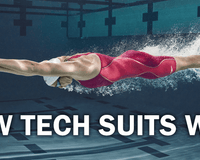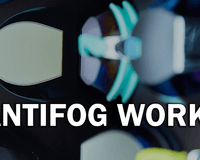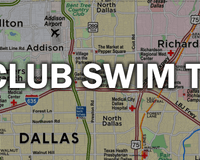We have a huge wall covered in goggles at the store. It's called, predictably, The Goggle Wall. We try to help out with choice paralysis. One of the questions we’re asked most is “which goggle is best?” The answer is usually this:
The best goggle is the one that doesn’t leak.
And then we try to find that goggle. Shopping online you don’t get to talk to me beside the Goggle Wall (though you’re aways welcome to email or call). If you were here, this blog is what I’d tell you. If you're short on time, use the Quick Guide below.
Quick Guide: The Best Goggles
We've linked mirrored where available, but most of these goggles come in clear and tinted variants.
Open Water & Triathlon Goggles
Best Open Water Goggles: Snake and Pig Basilisk, Aquasphere DEFY.Ultra
Best Triathlon Goggles: Aquasphere Xceed, Arena Cobra Core Swipe
Training & Competition Swim Goggles
Best All-Around Goggles: Speedo Vanquisher 2.0, Arena Tracks
Best Small Eye Socket Goggles: Aquasphere Kaiman Compact, Aquasphere Fastlane
Most Comfortable Goggles: Arena Air-Speed, Arena Air-Soft
Best Masters & Older Goggles: Aquasphere Kaiman, Aquasphere Mako
Prescription Goggles
Best Prescription Goggles: Speedo Vanquisher Optical, Speedo Vanquisher Optical Kids
Youth Swim Goggles
Best Youth Goggles (2-6yo): TYR Swimple, Aquasphere Moby
Best Youth Goggles (6-10yo): Speedo Hyperflyer, Arena Tracks Jr.
Best Youth Goggles (10-13yo): Speedo Jr. Vanquisher 2.0, Arena Tracks Jr, Snake & Pig Basilisk Junior
Racing Goggles
Fastest Racing Goggles: Arena Cobra Ultra Swipe
Most Comfortable Racing Goggles: Aquasphere Xceed
Best Budget Racing Goggle: Speedo Speed Socket 2.0
Bonus: Accessories
Best Training Accessory: FINIS Tempo Trainer
Best Smart Goggle: FINIS Smart Goggle
Best Strap: Smackstrap
Best Case: Arena Goggle Case
Here's our full guide for sifting through the many goggle options out there to find the right goggles for you.
How to Pick The Best Goggles
Open Water vs Pool
This is the most basic choice. An open water goggle is designed differently to a pool goggle. These can come either in half masks or look like traditional racing goggles. The priorities are for peripheral field of vision (to see your position in the water, and if you’re a Triathlete, the people swimming next to you), light weight, and padding for comfort.

(Trust us, if you’re doing triathlon or other group swimming events you want a goggle with cushion. We all get kicked in the face eventually.)
A pool practice or racing goggle, the kind you’ll see team swimming athletes wear, should be a lower profile, split lens design. You can use a mask or half mask if you’re swimming on your own for exercise, but if you’re a master’s swimmer or on a team, avoid any form of mask.
Eye Socket Size & Facial Features
The shape of your eye socket and the bridge of your nose play a the most important role in choosing the goggle that fits you. After sizing so many people we’re usually able to tell by looking, but take a selfie and consider the features of your face.
If you have a small eye socket you’ll want compact goggles or smaller frame goggles.
- If you have deep set eyes, larger goggle frames work best.
If your eye socket is shallow, you’ll want goggles with flatter gasket.
If you have a flatter nose bridge, a silicone nose piece that is molded into the goggle frame will work well, but you have the option of adjustable nose pieces as well.
If you have a pronounced nose bridge, or close set eyes, you will likely want an adjustable nose piece (most goggles that have adjustable nose pieces will have alternate sizes included in the packaging)
Older swimmers (either Masters or swimming for fitness) will typically do better in Aquasphere goggles like the Mako, Seal, Kaiman, or Kaiman Compact following the above considerations.
Some brands will have common traits in their fit. For instance, when looking at comparable goggle models, we notice that swimmers with almond shaped eyes typically face better in Speedo goggles while swimmers with rounder eyes will often do better in Arena. If you find a brand that works well, explore their other options.
*One thing we’ll note for sizing is Speedo’s Women’s Vanquishers are the same as the Men’s vanquishers. We’ve found no differences in size or construction, only the colors are different.
Lens Tint
If you’re swimming outside, go for a mirror or dark tint. The mirror finish will work like sunglasses. If you’re swimming indoors, lighter tints and clear mirrors are ideal, especially in low lighting. However, this isn’t a make or break thing with indoor goggles. Many swimmers, including myself, have spent years competing in mirrored goggles indoors because we like the look.

Gasket Material and Comfort
The gasket is the material that sits between the lens and the face, forming a seal against your skin to keep the water out. Gaskets come in silicone, rubber, and hard plastic (“Swedish” goggles). Between rubber and silicone, the standard line is that silicone is typically more comfortable as a gasket material while rubber seals better.

Our opinion is that if the goggle is well fitted, silicone will seal just as well as rubber. Our recommendation is to opt for silicone (which is how most practice and race goggles are constructed these days). Hard plastic Swedish goggles have devotees, and we sell them, but I can't recommend them.
Of note in silicone construction is Arena’s Air Soft and Air Speed line. The goggles are very similar, the main difference being the adjustable bridge in the Air Speeds. The goggle features a honeycomb-shaped gasket that seals well and is incredibly comfortable to wear, and is as close as we’ve found to a universal fit for a majority of adult swimmers.
Practice vs Racing Hydrodynamics: Picking the Fastest Goggle
Whether a goggle is suitable for practice or racing is determined by the goggle’s profile, and how it affects the hydrodynamics of your head’s contours. You may know of aerodynamics, affecting planes, trains, and cars, as how easily a streamlined shape can slip through the air with the least resistance resistance. Flat surfaces impact and disrupt the air, causing drag, while sleek surfaces allow air to be parted and pass over it cleanly. Hydrodynamics is the same, but in the water.

A racing goggle will generally be shallow and try to blend into the contours of your face. Arena’s Cobra Ultra Swipe for example, is designed to completely fill in shape of the eye socket to make your face more streamlined in the water.
Racing goggle lenses also sit closer to the eye – which means your eyelashes may brush against them. That can be uncomfortable or annoying during the course of training. Ultimately, even the most streamlined and high-tech of racing goggles will provide mere tenths of a second benefit over the course of most events, and for open water swimmers who do not have the benefit of moving through still water, it is almost totally a non-factor. Race in what you feel confident in.




